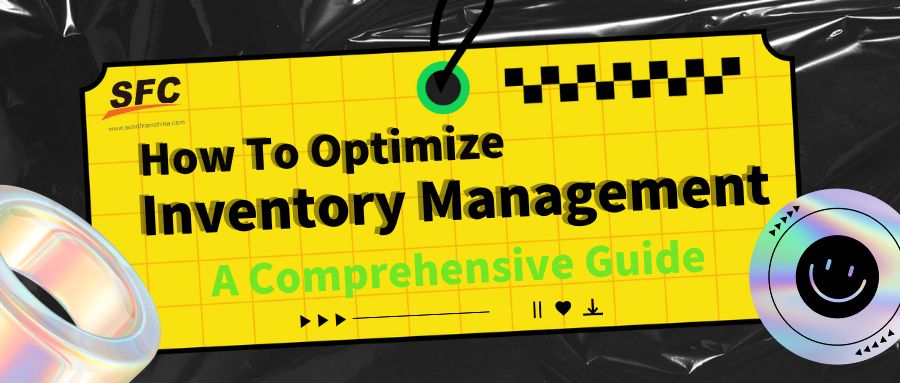Table of Contents
How to Optimize Inventory Management: A Comprehensive Guide
Time: Jun 29,2023 Author: SFC Source: www.sendfromchina.com
In today's competitive business environment, inventory management is not just a logistical concern—it is a strategic function that directly impacts a company's bottom line and customer satisfaction. Particularly in ecommerce, inventory management becomes a critical aspect of operations, determining the effectiveness of fulfillment processes and ultimately shaping the customer experience.
This blog post will offer an in-depth exploration of inventory management optimization, with a focus on ecommerce inventory management, 3PL fulfillment, ecommerce fulfillment, warehouse management systems (WMS), and other pertinent topics.

1. Understanding Inventory Optimization
Inventory optimization is the process of striking the right balance between the cost of holding inventory and the ability to serve customers promptly and efficiently. It involves maintaining an inventory level that minimizes costs (like storage and obsolescence) while ensuring that the right products are always available for fulfillment. The implications of not optimizing inventory could range from tying up capital in overstock to losing sales and damaging customer relationships due to stockouts.2. Key Strategies for Effective Inventory Management
Effective inventory management involves implementing a mix of strategic, operational, and technological measures. Here are some of the key strategies:2.1 Automating and streamlining processes: Automation not only reduces manual work but also increases accuracy and efficiency. Implementing an automated WMS can help businesses maintain real-time inventory data, automate order fulfillment, and streamline warehouse operations.
2.2 Maintaining an accurate inventory database: Having an accurate and updated inventory database prevents overstocking and stockouts, ensuring optimal inventory levels.
2.3 Developing an accurate forecasting model: A reliable forecasting model based on historical sales data, market trends, and promotional activities helps businesses anticipate future demand and plan inventory accordingly.
2.4 Implementing a centralized decision-making process: Centralized inventory management ensures a unified view of inventory across all sales channels, helping decision-makers to have a comprehensive understanding of stock levels.
2.5 Utilizing safety stock and cycle counting: Safety stock acts as a buffer against unexpected demand or supply chain disruptions. Regular cycle counting helps maintain inventory accuracy and quickly identify discrepancies.
2.6 Investing in automated solutions: Automated inventory management systems provide real-time visibility into inventory levels, aid in demand forecasting, and facilitate efficient order fulfillment.
2.7 Establishing strategic partnerships for efficiency and cost reduction: Engaging with third-party logistics (3PL) providers can help businesses enhance their inventory management efficiency and reduce costs related to order fulfillment and warehousing.
3. Inventory Optimization in Ecommerce
Ecommerce has been witnessing unprecedented growth, propelled further by the COVID-19 pandemic. However, this surge has also brought significant inventory management challenges. The dynamism and competitiveness of the ecommerce landscape require businesses to maintain optimal inventory levels, prevent stockouts, and ensure prompt fulfillment. Here are some strategies to tackle these challenges:3.1 Adopting suitable inventory management techniques: Techniques such as just-in-time, first-in, first-out, or drop-shipping can help businesses meet customer demands while minimizing costs. The choice of technique will depend on the nature of the product, the business model, and the predictability of demand.
3.2 Utilizing 3PL fulfillment services: 3PL order fulfillment servicers offer solutions for effective inventory management, ranging from inbound logistics and inventory distribution to consolidation and utilization. They can help reduce dock-to-stock cycle times, improve inventory accuracy, and increase the inventory turnover ratio.
3.3 Leveraging technology for demand forecasting and inventory accuracy: Implementing advanced analytics can help businesses analyze historical sales data and market trends to anticipate future demand more accurately. Similarly, using automated solutions like RFID and barcoding can improve inventory tracking accuracy.
3.4 Setting minimum stock levels: This strategy ensures that there is always a basic quantity of a product available to meet customer demand. It reduces the risk of stockouts and helps maintain service levels.
3.5 Creating a product hierarchy with ABC analysis: ABC analysis involves classifying inventory into three categories—A, B, and C—based on their importance. Category A includes high-value items with a low sales frequency; B includes moderate-value items with a moderate sales frequency, and C includes low-value items with a high sales frequency. This helps prioritize inventory management efforts based on product importance.
4. Role of 3PL Fulfillment and Multi-Client Fulfillment in Inventory Management
3PL providers are external companies hired to handle all logistics operations, including inventory management, warehousing, and transportation. Engaging a 3PL provider offers several benefits, such as access to a global distribution network, operational efficiency, and cost savings. They can help businesses strategically distribute inventory across fulfillment centers, reduce shipping times and costs, and eliminate the need for extensive logistics infrastructure.
Additionally, 3PLs can adopt a multi-client fulfillment model, providing a cost-effective alternative to dedicated fulfillment. This model requires changes in service offerings, commercial structure, warehouse operations, and technology but offers benefits like proximity to customers, lower overheads, flexibility, and economies of scale.
SFC--A Professional 3PL Order Fulfillment Service Provider
As a prominent technology-driven order fulfillment entity in China, SFC operates the Shenzhen Fulfillment Center and the Yiwu Fulfillment Center. Leveraging advanced software, we offer straightforward and dependable warehouse fulfillment services designed to cater to ecommerce entities, dropshipping enterprises, and crowdfunding initiatives.At SFC, our dedication lies in offering a safe storage environment, effective order fulfillment, a range of personalized packaging options, adaptable shipping strategies, and various other supplementary services. Our goal is to aid in the expansion of your business in a cost-effective and efficient manner.
5. Choosing the Right Warehouse Management System (WMS)
A robust WMS can significantly streamline inventory management processes and improve efficiency. While choosing a WMS, businesses should consider factors like the ability to provide centralized inventory management, demand forecasting, multi-warehouse support, batch and expiration tracking, and inventory reorder alerts.These features help prevent stockouts, provide accurate data for decision-making, and optimize inventory levels. A scalable, user-friendly system with an intuitive interface and robust reporting tools can further add to the system's effectiveness.
 Post Views:12985
Post Views:12985
Copyright statement: The copyright of this article belongs to the original author. Please indicate the source for reprinting.
Previous Post
Inventory Turnover Ratio: Optimizing Your Inventory Management
Next Post
TAGS
Hot Research
Get a Custom China Fulfillment Solution with FREE Storage for 30 Days
 Want to know about our services, fees or receive a custom quote?
Want to know about our services, fees or receive a custom quote?
 Please fill out the form on the right and we will get back to you within a business day.
Please fill out the form on the right and we will get back to you within a business day.
 The more information you provide, the better our initial response
will be.
The more information you provide, the better our initial response
will be.






 TAGS:
TAGS: